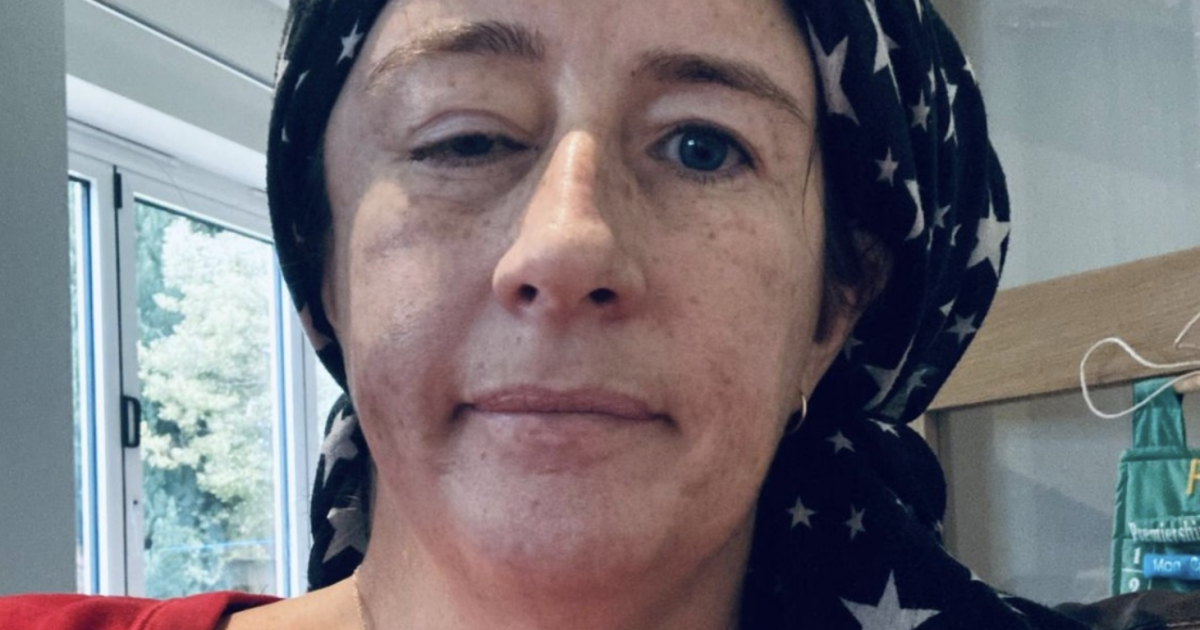A Woman Learns She Has A Brain Tumor, And Then Waits A Year For Surgery
- Kristy Dury first learned about her brain tumor in November 2019 when she sought treatment for a case of conjunctivitis. The working mom with four kids had been experiencing intense pressure headaches at the time and one of her eyes was bloodshot.
- She would not have the surgery to remove that tumor until a year after her diagnosis because of the COVID pandemic and her operation not being deemed an emergency surgery. In the end, doctors removed her meningioma and no cancer was detected by doctors.
- It can be difficult to identify the symptoms of a meningioma. Even when the symptoms are identified, it can be easy to assume there is some other underlying cause. Less than 20 percent of these growths prove to be cancerous,
Kristy Dury first learned about her brain tumor in November 2019 when she sought treatment for a case of conjunctivitis.
Read More

“I was lucky that the doctor took my swollen eye seriously, I was lucky he sent me to the hospital that same day, I was lucky that I saw a consultant at the hospital and that I got a CT scan straight away,” recalls Dury in a post about her experience. “Because by 6 pm that day, we all knew. I just didn’t understand yet.”
Dury learned that she had a meningioma, a slow-growing tumor that could be cancerous. She scheduled surgery to remove the tumor early in the new year and then returned to her life as if nothing had happened that day.
Dury admits now that she did not handle things in the best possible way, returning to work after just a single day off to digest the news.
And once back at work, she started to voice her opinions more frequently, with little concern about how they might land.
“The erratic behavior was a strong feature of my first few months, really. I have always been plain-talking, but it reached new heights during this time, as any filters I might have had departed me. I felt that life was too short to dance around my handbag and not say exactly what I was thinking,” recalls Dury.
“So if I thought it, I said it. Loudly! Not the best career-wise, but I had taken the precaution of telling people at my office what was happening, and most were understanding.”
With her surgery scheduled for February, Dury started preparing for the big day. She had numerous appointments with doctors to iron out the physical aspects of the surgery but says she ignored the emotional aspects of the trauma while adopting a fatalistic mindset.
Dury writes: “We were both having very dark thoughts and consequently I, in particular, was becoming very difficult to live with and a total misery to be around. Despite the good outlook for people with my condition, I’m afraid that it’s too easy to automatically assume worst case for everything and struggle to see the positives. I was also refusing to plan anything too far ahead, fearful of what the future might bring.”

In the end, it was fitness that ended up being Dury’s salvation.
“Most of the people I met were all softly spoken and sympathetic – not at all the kind of people I engage with. Even the leaflet in the lobby used sad language with heavy overtones of death. I was fairly sure we weren’t going to keep going there,” recounts Dury of her first attempt to find emotional support.
“Then I met the Occupational Therapist at the Spring Centre. She sussed me straight away, quickly adapted her approach, and had the measure of me in minutes. In only our first meeting, I learned that I had to take more time away from work to come to terms with my diagnosis and that I had to exercise to be able to manage my mental health.”
That came in handy as the COVID pandemic rolled in, and Dury watched her surgery get pushed back time and time again.
Because meningiomas are so slow-growing and most are not cancerous, Dury’s operation did not qualify as emergency surgery.
It was not until November 20, a full year after her diagnosis, that she finally prepared to go into surgery and learn if she had cancer.

“The next two weeks leading up to the surgery are a blur. We were trying to get everything ready for Christmas (as we knew I wouldn’t be up to it in December), go to all the medical appointments, keep our daughter in school, not catch Covid, and both hold down full-time jobs” writes Dury of her preparations.
“The medical appointments were pretty grim by this stage, as the team prepared us by explaining how they would do the surgery and talking through the risks. I don’t think either of us properly listened to the risks – if you did, I genuinely don’t think you would go through with the operation. Highlights were loss of vision, a stroke or death!”
She continues: “I don’t think you need to hear the detail of what they actually planned to do. Suffice to say, they would remove as much tumor as they could, remove the infected bone from my skull, then re-build my skull and eye orbit.”
Then, the big day came, and the surgery proved to be a success. Even better, the meningioma was not cancerous, and Dury had made it through what she now calls her “Annus Horribilis.”
Dury then states that she does not want attention and is not seeking sympathy by sharing her story.
“I do this simply to try and improve awareness of conditions like mine and to offer hope to those who receive a devastating diagnosis,” writes Dury. “I want to educate managers of people and offer insight as to what your employees might be going through.”
She does then note, however: “I won’t lie – it has been therapeutic for me, but that wasn’t actually the point.”
What Are Symptoms of a Meningioma?
Dury hadn’t considered that she might have a brain tumor before her diagnosis.
That is because it can be challenging to identify the symptoms of a meningioma. It is also easy to assume there is some other underlying cause for the symptoms.
And because of the rate at which meningiomas grow, these changes can be subtle over time.
Some common symptoms are:
- Vision changes
- Loss of hearing or smell
- Confusion
- Seizures
- Headaches that are worse in the morning
In some cases, meningiomas will be cancerous.
Once they become cancerous, the tumor starts to grow at a faster rate and can quickly spread through the brain and then move into the spinal cord.
In most cases, a malignant brain tumor is a secondary cancer.
Malignant brain tumors are difficult to treat, though there are some instances when a surgeon can surgically remove the tumor.
Survival rates for malignant brain tumors are among the lowest, but most individuals who survive five years make it to the ten-year mark. Overall, 40 percent of people live at least one year, 19 percent make it to five years, and 14 percent survive ten years after their diagnosis.
New Hope For Glioblastoma Patients
Signs And Symptoms of Malignant Brain Tumor
The signs and symptoms of a malignant brain tumor can vary significantly based on the cancer’s size, spread, and location.
As a result, some individuals will not feel any real effects for some time, while others will start to show symptoms almost immediately after the cancer starts to grow.
Common symptoms include:
- Intense and frequent headaches
- Intense pressure similar to a sinus infection
- Seizures
- Body tremors
- Nausea
- Fatigue
- Sudden changes in behavior
- Shifts in personality
- Short-term memory loss
- Weakness of the legs and/or arms in one side of the body
- Blurred vision
- Difficulty speaking and remembering words
Individuals who experience multiple symptoms for an extended period of time should schedule an appointment with their doctor.
Fighting Brain Cancer With Electric Fields
Learn more about SurvivorNet's rigorous medical review process.


